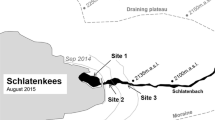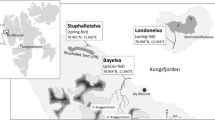Abstract
Floodplains are dynamic wetlands that are constantly alternating between aquatic and terrestrial phases. To survive these conditions, aquatic invertebrates must have life history strategies allowing them to take advantage of inundation periods. One such strategy is growing rapidly and completing development before flood waters recede. We measured daily growth rates and development times of 7 chironomid species during April, June, and August using egg masses collected from the Sipsey River floodplain, west central Alabama, USA. Egg masses and resulting larvae were reared under ambient temperatures (18–27°C) and with a natural food source. All successfully reared chironomids were in the subfamily Chironominae. Mean growth rate was 0.28 d-1 suggesting a biomass turnover time of 3 days. Mean development time was 17 days. Temperature affected chironomid development time, with slower rates occurring at the lowest temperature. While many chironomid species appear capable of rapid growth in floodplains when temperatures are >18°C, completion of their life cycle seems likely only if inundation persists at least 2–3 weeks. Longer inundation periods are probably necessary for chironomids to complete their life cycle at colder temperatures in winter and early spring.

Similar content being viewed by others
References
Benke AC (1990) A perspective on America's vanishing streams. J N Am Benthological Soc 9:77–88
Benke AC (1998) Production dynamics of riverine chironomids: extremely high biomass turnover rates of primary consumers. Ecology 79:899–910
Benke AC (2001) Importance of flood regime to invertebrate habitat in an unregulated river-floodplain ecosystem. J N Am Benthological Soc 20:225–240
Benke AC, Cushing CE (eds) (2005) Rivers of North America. Elsevier, Boston
Benke AC, Jacobi DI (1986) Growth rates of mayflies in a subtropical river and their implications for secondary production. J N Am Benthological Soc 5:107–114
Benke AC, Hauer FR, Stites DL, Meyer JL, Edwards RT (1992) Growth of snag-dwelling mayflies in a blackwater river: the influence of temperature and food. Arch Hydrobiol 125:63–81
Benke AC, Huryn AD, Smock LA, Wallace JB (1999) Length-mass relationship for freshwater macroinvertebrates in North America with particular reference to the southeastern United States. J N Am Benthological Soc 18:308–343
Benke AC, Chaubey I, Ward GM, Dunn EL (2000) Flood pulse dynamics of an unregulated river floodplain in the southeastern U.S. Coastal Plain. Ecology 81:2730–2741
Berg MB, Hellenthal RA (1992) Life histories and growth of lotic chironomids (Diptera: Chironomidae). Ann Entomol Soc Am 85:578–589
Bouchard RW, Ferrington LC (2009) Winter growth, development, and emergence of Diamesa mendotae (Diptera: Chironomidae) in Minnesota streams. Environ Entomol 38:250–259
Cross WF, Johnson BR, Wallace JB, Rosemond AD (2005) Contrasting response of stream detritivores to long-term nutrient enrichment. Limnol Oceanogr 50:1730–1739
Entrekin SA, Golladay SW, Batzer DP (2001) The influence of plant community on chironomid secondary production in two wetland types: cypress-gum swamps and grass-sedge marshes. Arch Hydrobiol 152:369–394
Epler JH (2001) Identification manual for the larval Chironomidae (Diptera) of North and South Carolina. Special Publication SJ2001–SP13. North Carolina Department of Environment and Natural Resources, Raleigh, North Carolina and St Johns River Water Management District, Palatka, Florida. (Available via. http://home.comcast.net/∼johnepler3/index.html)
Frisch D (2002) Dormancy, dispersal and the survival of cyclopoid copepods (Cyclopoida, Copepoda) in a lowland floodplain. Freshw Biol 47:1269–1281
Gladden JE, Smock LA (1990) Macroinvertebrate distribution and production on the floodplains of two lowland headwater streams. Freshw Biol 24:533–545
Gray LJ (1980) Recolonization pathways and community development of desert stream macroinvertebrates. Dissertation, Arizona State University
Gresens SE (1997) Interactive effects of diet and thermal regime on growth of the midge Pseudochironomus richarsoni Malloch. Freshw Biol 38:365–373
Hauer FR, Benke AC (1987) Influence of temperature and river hydrograph on black fly growth rates in a subtropical blackwater river. J N Am Benthological Soc 6:251–261
Hauer FR, Benke AC (1991) Rapid growth of snag-dwelling chironomids in a blackwater river: the influence of temperature and discharge. J N Am Benthological Soc 10:154–164
Huryn AD (1990) Growth and voltinism of lotic midge larvae: patterns across an Appalachian Mountain basin. Limnol Oceanogr 35:339–351
Huryn AD, Wallace JB (1986) A method for obtaining in situ growth rates of larval Chironomidae (Diptera) and its application to studies of secondary production. Limnol Oceanogr 31:216–222
Jackson JK, Sweeney BW (1995) Present status and future directions of tropical stream research. J N Am Benthological Soc 14:5–11
Konstantinov AS (1958) The effect of temperature on growth rate and development of chironomid larvae. Ser Biologiya 20:506–509
Ladle M, Cooling DA, Welton JS, Bass JAB (1985) Studies on Chironomidae in experimental recirculating stream systems 2: the growth, development and production of a spring generation of Orthocladius (Euorthocladius) Calvus Pinder. Freshw Biol 15:243–255
Mackey AP (1977) Growth and development of larval Chironomidae. Oikos 28:270–275
Menzie CA (1981) Production ecology of Cricotopus sylvestris (Fabricius) (Diptera: Chironomidae) in a shallow estuarine cove. Limnol Oceanogr 26:467–481
Nebeker AV (1973) Temperature requirements and life cycle of the midge Tanytarsus dissimilis (Diptera: Chironomidae). J Kans Entomol Soc 46:160–165
Nolte U, Hoffmann T (1992) Fast life in cold water: Diamesa incallida (Chironomidae). Ecography 15:25–30
Oliver DR (1971) Life history of the Chironomidae. Annu Rev Entomol 16:211–230
Ramirez A, Pringle CM (2006) Fast growth and turnover of chironomid assemblages in response to stream phosphorus levels in a tropical lowland landscape. Limnol Oceanogr 51:189–196
Reynolds SK, Benke AC (2005) Temperature-dependent growth rates of larval midges (Diptera: Chironomidae) from a southeastern US stream. Hydrobiologia 544:69–75
Salas M, Dudgeon D (2001) Laboratory and field studies of mayfly growth in tropical Asia. Arch Hydrobiologia 153:75–90
Salas M, Dudgeon D (2003) Life histories, production dynamics and resource utilisation of mayflies (Ephemeroptera) in two tropical Asian forest streams. Freshw Biol 48:485–499
Stites DL, Benke AC (1989) Rapid growth rates of chironomids in three habitats of a subtropical blackwater river and their implications for P:B ratios. Limnol Oceanogr 34:1278–1289
Tronstad LM, Tronstad BP, Benke AC (2005a) Invertebrate responses to decreasing water levels in a subtropical river floodplain wetland. Wetlands 25:583–593
Tronstad LM, Tronstad BP, Benke AC (2005b) Invertebrate seedbanks: rehydration of soil from an unregulated river floodplain in the south-eastern US. Freshw Biol 50:646–655
Tronstad LM, Tronstad BP, Benke AC (2007) Aerial colonization and growth: rapid invertebrate responses to temporary aquatic habitats in a river floodplain. J N Am Benthological Soc 26:460–471
Walther DA, Whiles MR, Flinn MB, Butler DW (2006) Assemblage-level estimation of nontanypodine chironomid growth and production in a southern Illinois stream. J N Am Benthological Soc 25:444–452
Ward GM, Harris PM, Ward AK (2005) Gulf coast rivers of the southeastern United States. In: Benke AC, Cushing CE (eds) Rivers of North America. Elsevier, Boston, pp 124–178
Acknowledgments
We thank Bill Burks and the Alabama Department of Conservation and Natural Resources State Lands Division for allowing us to conduct research at the Sipsey River Forever Wild Tract. The University of Alabama Department of Biological Sciences and University of Alabama Student Government Association supported our research. Comments from Darold Batzer and two anonymous reviewers improved the manuscript.
Author information
Authors and Affiliations
Corresponding author
Rights and permissions
About this article
Cite this article
Tronstad, L.M., Tronstad, B.P. & Benke, A.C. Growth Rates of Chironomids Collected from an Ephemeral Floodplain Wetland. Wetlands 30, 827–831 (2010). https://doi.org/10.1007/s13157-010-0074-2
Received:
Accepted:
Published:
Issue Date:
DOI: https://doi.org/10.1007/s13157-010-0074-2




